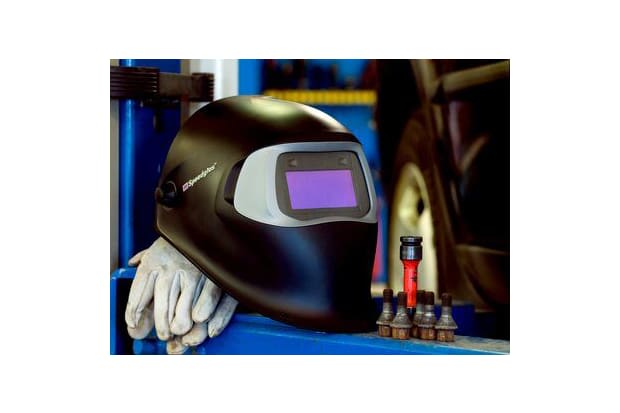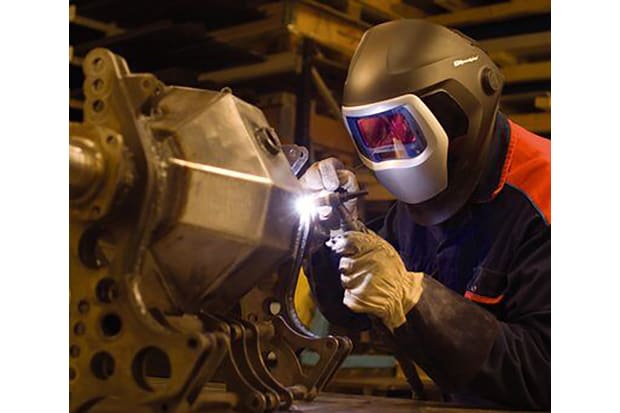- Published 15 Nov 2022
- Last Modified 18 Mar 2024
- 5 min
A Guide to Welding Masks
Learn all about welding masks, helmets, and PPE for welders in this comprehensive guide.

Functional, heat-resistant PPE is essential for working safely – especially when welding. The process of welding can be extremely dangerous without the correct equipment, with hazards ranging from heat generation and flying sparks, to UV radiation and toxic fumes.
Welding can be particularly dangerous for the eyes, so appropriate PPE and welding masks must be worn. Thanks to state-of-the-art technology, there are now plenty of safe and comfortable equipment options to choose from for MIG, MAG, and other welding work.
Types of Welding Masks
Some common types of welding masks, helmets, and shields are explored below in greater detail:
Key Features of Welding Masks

Welding masks and helmets come with many different options, but it’s important to choose the best product to meet your requirements. A good mask should be both secure and comfortable – light and well-padded for comfort, yet adjustable via straps to adapt flexibly to the wearer’s head shape.
Some other key features and useful considerations are outlined below:
Auto-Darkening
With auto-darkening technology, optical sensors darken and brighten the field of vision. As soon as light is emitted during welding, the field of view darkens in a split second and will brighten again when the welding process pauses or ends.
Level of Shading
The appropriate protection level needed will depend on both the light intensity and the specific welding process being used. The level of shading on a welding mask is a key consideration, determining the strength of the protection against the arc and light levels.
Viewing Area
Different styles of welding masks or helmets incorporate differences in the lens sizes of the visor. As a rule, the larger the field of view, the more comfortable it will be to work. Additionally, automatic helmets generally have a smaller field of vision so may not be suitable if you would prefer a larger viewing area.
Reliability
PPE is always important in the workplace, and this is also the case when welding. Choosing quality, reliable equipment from trusted manufacturers is essential as safety should never be compromised. You will also need to regularly inspect and maintain your mask, replacing any damaged parts to ensure it remains at peak performance.
How Do Auto-Darkening Welding Masks Work?
There are four important components in auto-darkening welding helmets:
- LCD Screen: The liquid crystal display darkens the incoming light depending on the protection level set. It’s designed to protect eyes against light flashes and the brightness of the arc
- Ultraviolet and Infrared Filter: This shields the eyes from invisible light, protecting against harmful UV and infrared rays
- Photocell: Optical sensors measure the wavelength of the light and thus the intensity of the arc
- Electronics: Control elements send the signals from the photocells to the LCD screen and light filters. This ensures auto-darkening, depending on the settings selected
The three most important factors when setting up an auto-darkening welding mask are shade level, photosensitivity, and darkening time. There are no fixed guidelines for the latter – it can simply be adapted to the individual needs of the user. However, it is recommended to adjust it more sensitively for safety reasons.
What Do Welding Masks Protect You From?
Considerable energy must be applied to permanently join one or more workpieces together by welding. However, it’s not only the high temperatures that are a hazard. Glaring light, flying sparks, loud noise levels, and dangerous or sometimes flammable gases and fumes can also be harmful. Therefore, appropriate working conditions and the right protective equipment are essential for safe, efficient welding.

The three major dangers of welding are:
- Light: The bright light emitted when welding can dazzle the eyes. However, even invisible ultraviolet and infrared rays can cause permanent damage to the eyes
- Flying Sparks: Sparks resulting from welding can fly metres away, reach extremely high temperatures, and cause severe burns if they meet unprotected skin
- Hazardous Gases: All welding processes produce fumes and gases such as carbon monoxide, nitrogen oxide, metal oxide, or ozone. Health can be seriously impacted if toxic vapours are inhaled continuously or in excessive concentrations
The eyes and face are particularly at risk as they are among the areas most exposed to the effects of welding. During arc welding, light enters the ultraviolet and infrared ranges. This glaring light can have an extreme effect on unprotected eyes in just fractions of a second – leading to painful and possibly even permanent damage.
Therefore, conventional safety goggles and glasses are unsuitable for any type of welding work. Although they will protect against heat and flying sparks, they do not offer protection against glare. Proper welding PPE should always be worn to ensure full protection.
Appropriate protective equipment such as welding masks and helmets not only protects against the light. They also safeguard against welding spatter (molten metal droplets), short-term contact with flames, radiant heat, and to a limited extent, electrical current.


